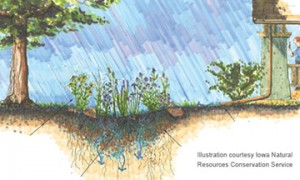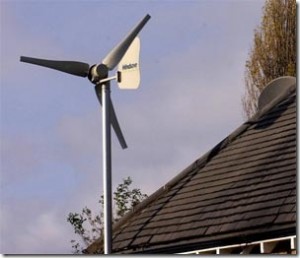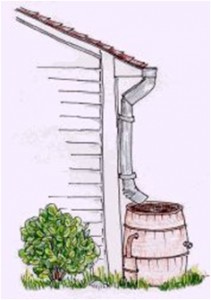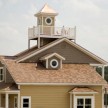Sustainable Residential Design
SUSTAINABLE RESIDENTIAL DESIGN: INCREASING ENERGY EFFICIENCY
INCREASING ENERGY EFFICIENCY
An increasingly important component of residential design and construction is sustainable design.
Sustainable Residential Design is basically wise decision making about materials and land use and maximizing a site and building energy efficiency.
There are many ways that your architect can help you save energy in your existing home or in your new home design: Insulation and caulking, weather proofing, energy efficient appliances (cooking, dish washing, clothes washing and drying), setback thermostats, weather tight windows, solar panels, and water conservation to name a few methods. But a landscape architect can dramatically improve a home’s efficiency and lower operating expenses with proper site location and orientation, solar gain, plantings (winter wind blocking, summer shading), and water consumption.
Inefficient home energy use is not only costly, but also contributes to the growth of greenhouse gas (GHG) emissions, a major cause of climate change. Residential  and commercial buildings use ten percent of U.S. energy.
Through “integrated site design,” a comprehensive approach to sustainable building and site design, sustainable residential landscape architecture practices can not only improve the environment, but also increase energy efficiency for the individual home owner. If part of a broader integrated site design, sustainable residential landscape architecture can dramatically reduce energy costs over the long term while creating a healthy residential environment.
and commercial buildings use ten percent of U.S. energy.
Through “integrated site design,” a comprehensive approach to sustainable building and site design, sustainable residential landscape architecture practices can not only improve the environment, but also increase energy efficiency for the individual home owner. If part of a broader integrated site design, sustainable residential landscape architecture can dramatically reduce energy costs over the long term while creating a healthy residential environment.
Integrated site design is a framework for increasing the quality of the built environment, and involves maximizing existing natural systems to minimize energy usage. These types of designs leverage the many benefits of natural systems which cuts down significantly external energy use. Decreased energy usage also means homes are more resilient to shifts in the availability of energy and climate change. The following are examples of some options available to reduce energy usage:
1. Tree Plantings:
The energy efficiency benefits of sustainable landscape architecture practices, including age-old practices like tree siting for shading (cooling) and wind buffering (heating). Homeowners can plant shade trees to insulate residential buildings and minimize home heating and cooling costs. Tree can be optimally sited around homes to increase energy efficiency. Certain types of trees can provide heating benefits in winter and cooling effects in summer.
”Green side up”
2. Solar Power: 
The use of photovoltaic solar power systems on homes is growing in popularity. A number of U.S. states, including California, provide a range of incentives for homeowners to install rooftop solar energy systems, giving homeowners the opportunity to reduce energy costs and even sell their energy back to the central grid. Germany and a number of Scandinavian countries are leaders in residential solar power use.
Cost efficiency: Solar panels can significantly reduce electricity bill especially during winter time
Economic incentives: Net metering and tax incentives
Grid-connection: Homeowners can sell excess power back to the central grid
Sources:
“A Consumer’s Guide: Get your Power from the Sun,” U.S. DOE
“5 Ways to Greenify Your Home,” How Stuff Works.com
3. Wind Power:
Wind power is a tremendously efficient source of energy at a large scale. There are companies that are working on prototype smaller compact turbines designed for personal use. Solar and wind complement each other well, providing an energy source year round.
4. Residential Green Roof Systems:
These systems can store water, reduce home heating and cooling costs and reduce the reflectivity of a roofing system to reduce the green house effect.
5. Water Conservation:
There are many ways to promote water conservation. Simple solutions like:
- Rain barrels to store rain water for use during dry times.

- Rain gardens use plantings and soils to promote storm water detention, rain water infiltration while beautifying your property. A rain garden is a specially designed garden, with a man-made depression, that collects and infiltrates runoff from impervious surfaces such as a roof, driveway, or parking lot.
- Rain gardens are usually planted with native flowering, plants, and grasses. Each rain garden design is unique and dependent on the site condition and the owner’s personal tastes.
- The runoff diverted to the rain garden soaks into the ground and is used by the plants rather than being a potential cause of erosion and the carrying of pollutants (sediment, lawn fertilizers, and pet droppings) to the nearest creek, stream, or river.
- Efficient irrigation system design. Limiting irrigation to the essential plants and lawn areas and allowing meadows, fields and ‘naturally’ occurring plants to take over and thrive
Sustainable design can be integrated into all site design. Wise decision choices about materials, orientation, water use, alternative energy and plantings will go a long way to create a healthy and environmentally friendly home site.
Guest Author:
David Fisher is a registered Landscape Architect and Principal of Fisher Design Group in Concord, MA offering services to homeowners, commercial clients and government and non-profit organizations. He is actively involved in promoting and enhancing Concord’s rich and sensitive heritage.
David Fisher can be reached at: www.fisher-designgroup.com Concord, MA 01742 978.996.5713 t
————————————————————————————————————————————

















